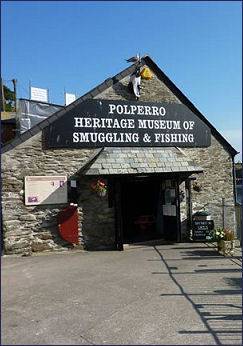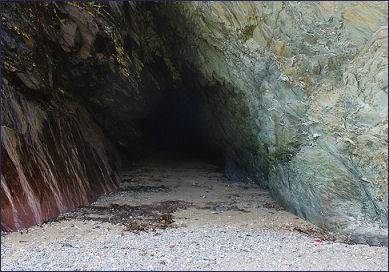Polperro Heritage Museum of Smuggling and Fishing
OS Grid ref:-
 The Polperro Heritage Museum of Smuggling and Fishing is situated on the harbourside in the picturesque fishing village of Polperro.
The Polperro Heritage Museum of Smuggling and Fishing is situated on the harbourside in the picturesque fishing village of Polperro.
The Museum provides a fascinating insight into the history of fishing and smuggling from the late eighteenth century to the present. Due to the geography of the coastline and the ingenuity of many of its residents, Polperro became both a place to deliver contraband and also to deposit the smugglers' takings.
The museum houses a remarkable photographic record dating from around 1860. The collection is complemented by a wonderful collection of ships models. Family history is also well catered for with records available for viewing.
The collection is housed in what was the old pilchard factory until the early twentieth century. For many centuries Polperro flourished from the pilchard trade and it was even a Polperro resident, Jonathan Couch, who first identified the fish as a large sardine. Smuggling is understood to have prospered since Polperro developed as a port in the twelfth century. By the late eighteenth century, much of the success of the smuggling trade through Polperro was controlled by Zephaniah Job (1749-1822), a local merchant who became known as "The Smuggler's Banker".
 Although for centuries Polperro's main source of income was fishing, in the eighteenth and nineteenth centuries it was also a very lively centre of Free Trade. Crippling taxes on tea and brandy meant that it cost six times as much in Britain as it did on the continent. Gin, rum and tobacco were other commodities brought quietly ashore in the dead of night. Much of the brandy, gin, tea and tobacco shipped across the Channel came from Guernsey where they were readily available at much lower prices than in England where they attracted heavy duty.
Although for centuries Polperro's main source of income was fishing, in the eighteenth and nineteenth centuries it was also a very lively centre of Free Trade. Crippling taxes on tea and brandy meant that it cost six times as much in Britain as it did on the continent. Gin, rum and tobacco were other commodities brought quietly ashore in the dead of night. Much of the brandy, gin, tea and tobacco shipped across the Channel came from Guernsey where they were readily available at much lower prices than in England where they attracted heavy duty.
A more organised Coast Guard service was introduced in the nineteenth century together with the deterrent of stiff penalties, leading to much less smuggling.
The cave on the western side of the beach at Polperro is known as Willy Wilcox Cave, after a Polperro smuggler who drowned in the cave while hiding from Customs men.
A colourful Polperro legend relates the story of 'Battling Billy', who ran the Halfway House Inn in the village. Faced with the problem of transporting brandy inland without being detected he came up with the idea of using a hearse. His ruse worked well for a time, but problems arose when one cargo had to be unloaded in daylight. Just as the last keg was being lifted into the hearse, the revenue men appeared on the scene, Billy whipped the horses into a ferocious gallop, with the customs men in pursuit. A bullet was fired through Billy's neck and with his head hanging limp and lifeless, the horses continued on. When they reached Polperro, the hearse containg the dead man was said to have driven straight down the main street, off the quayside and into the harbour.
Pirates, Smugglers and Wreckers
Visitor Attractions in Cornwall